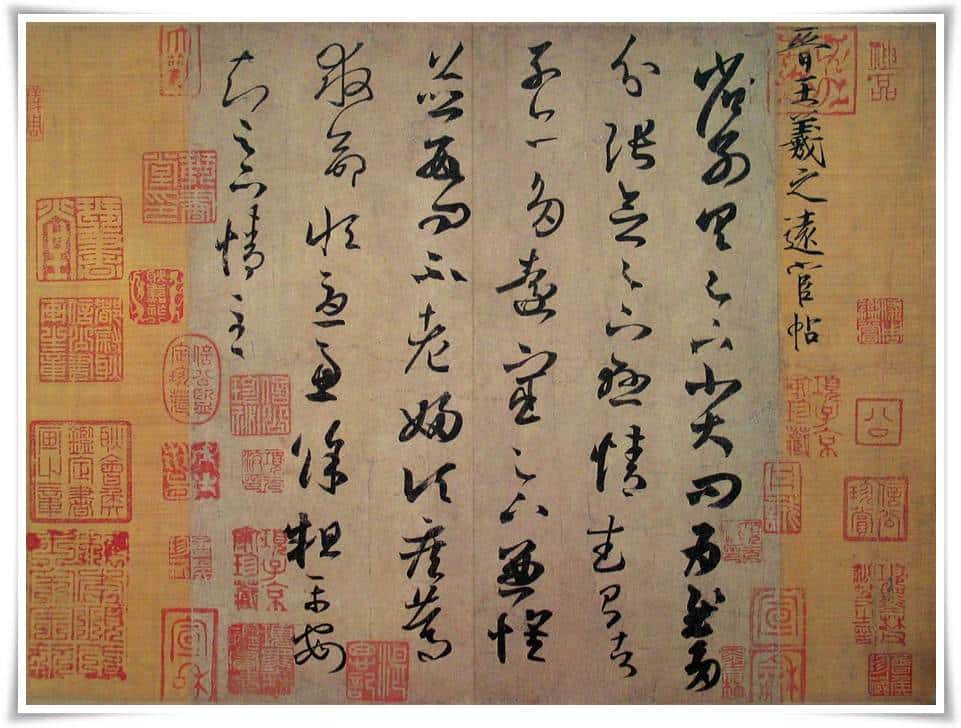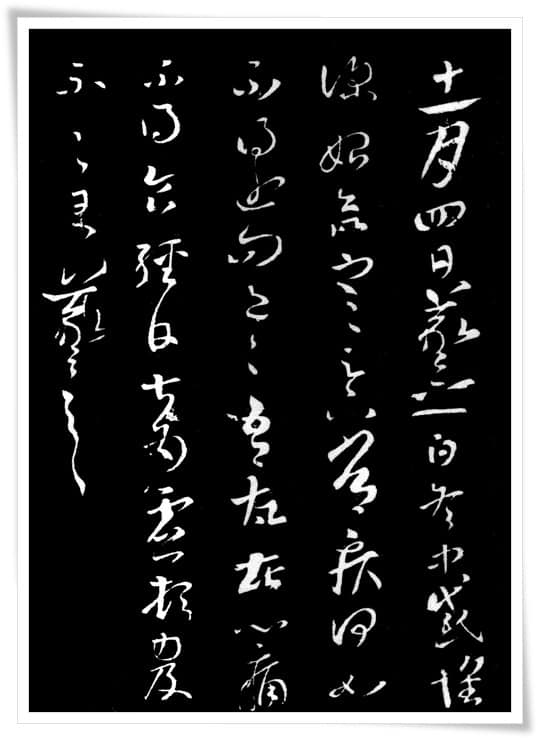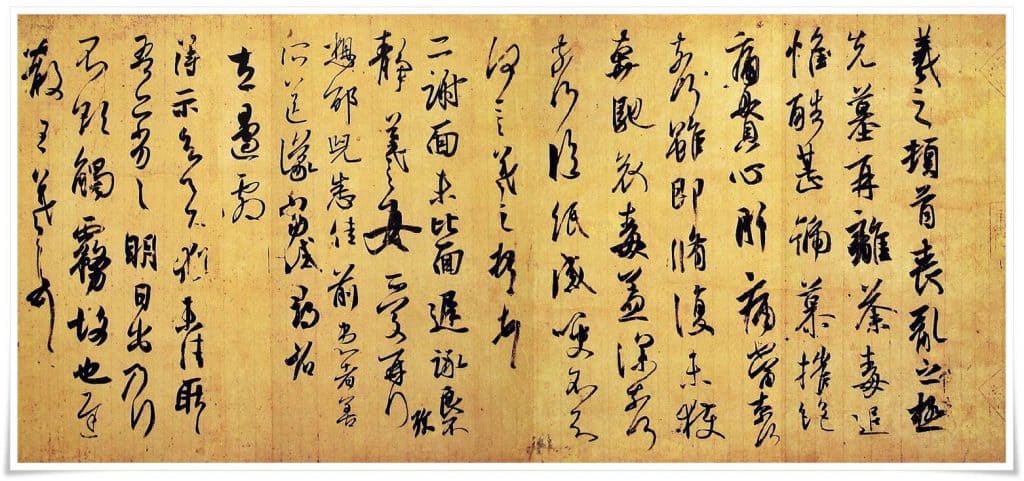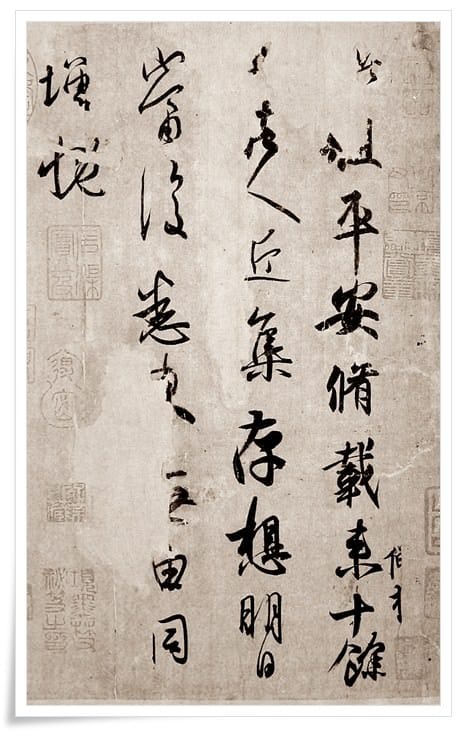Ancient Chinese calligraphy differs greatly from modern calligraphy. Aside from the obvious changes aesthetically, the very purpose of writing was no longer the same. When brush and wood, and brush and paper in later times were the only means of communicating one’s thoughts and ideas, decrees, messages of various kinds, poetry, etc., to other members of society, calligraphy was very closely related to politics and to one’s station in life. Learning the skill of writing was mainly reserved for the nobility and monks. Thus, the majority of the most renowned calligraphers were politicians, even if that path was against their nature or desire, which, according to texts, one can assume was often the case. The more refined, elegant and skillful was one’s handwriting, the better were his or her (though there were only a few famous women calligraphers in Ancient China) opportunities for the elevation of status.

Due to cultural and historical contexts, some of the most cherished calligraphy classics are politically related texts, praise for an Emperor, a description of a state-level event, and so forth. Naturally, it was believed that an important document ought to be written by a skilled hand and usually in the official script of a given historical period. In order, oracle bone script (甲骨文, こうこつぶん, kōkotsubun) and kinbun(金文, きんぶん, i.e.”text on metal”) (both existed and were used in parallel though, their purpose was slightly different) was followed by other forms of seal script (篆書, てんしょ, tensho), clerical script (隷書, れいしょ, reisho) and then finally standard script (楷書, かいしょ, kaisho) was used. Official documents were rarely written in cursive (草書, そうしょ, sōsho) or semi-cursive (行書, ぎょうしょ, gyōsho) hand as both scripts were, and still are, considered to be for more casual communication.
Fortunately, official documents do not exhaust the subject of ancient Chinese calligraphy classics. There is an abundance of personal letters, poems, short notes, etc., which are executed in either an emotional or a rather relaxed manner, revealing a whole new universe of astonishing art. This article will focus on the correspondence of the Sage of Calligraphy, Wang Xizhi.

According to the outstanding calligrapher and theoretician of the early Tang dynasty (唐朝, pinyin: Táng Cháo, 618 – 907 C.E.), Sun Guoting (孫過庭, pinyin: Sūn Guòtíng: 646–691), also known as Sun Qianli (孫虔禮, pinyin: Sūn Qiánlǐ), there are five harmonies and five discords as laid out in his book Shu Pu (書譜, pinyin: Shū Pǔ, i.e. “Treaties on Calligraphy”). The first and second harmonies are being happy in spirit and free from worries and having a rested mind and body. He also states that to be able to write powerful and beautiful calligraphy, all of the five harmonies must coexist together, simultaneously. From personal experience as a calligrapher, when the mood is right, the weather is pleasant, and the Four Treasures (文房四宝, ぶんぼう しほう, bunbō shihō) are a perfect match, there is a sudden desire to write, the heart soars, and the brush glides over the paper surface like a wild dragon in clouds. An exploration of the connection of this theory to the epistles of Wang Xizhi follows.
Last year, a group of Japanese calligraphers led by Master Calligrapher Kajita Esshu (梶田越舟先生, かじた えっしゅう せんせい, Kajita Esshū Sensei) researched, analyzed and copied letters of Wang Xizhi. Many months were spent analyzing short letters, considered to be masterpieces. Of particular interest is that in the majority of those letters, Xizhi writes with complaints about bad weather, heavy rains, cold, and the like, indicating that he was either worried about his health, was already sick, or felt weak. Yet still, the line spawned by his brush appears as strong as an army of 10,000 men, unhesitant as a striking tiger, and graceful as wild cranes in flight. There is only one way to explain this phenomenon. His skill was so highly elevated that it’s placement was simply sitting above the five harmonies that Sun Qianli outlined in his writings. His skill must have been the sixth harmony, negating the others, self-sufficient, independent and superior to any distraction of the surrounding world. It became clear as to why he is called the Sage of Calligraphy.

A total of 21 copies of Wang Xizhi works survived. All of them were created during the Tang dynasty by the order of Emperor Taizong of Tang (唐太宗, pinyin: Táng Tàizōng, 599 – 649), who was obsessed with his calligraphy. The collection of Xizhi’s letters belongs to this pool of masterpieces, though usually the collections of letters count as one masterpiece. His epistles can be divided into two major groups, one would be those written in cursive script, the other in semi-cursive.
Letters in cursive hand are particularly interesting as they often contain character forms that were created by Xizhi, and often times cause trouble for modern calligraphers. Master Calligrapher Kajita Esshu often would point out a character that, in his and other scholars’ opinion, had a questionable cursive script form. It is always possible that the person who copied the work may have made a mistake. Then again, knowing the reputation and skill of those imperial court calligraphers that were ordered to copy Xizhi’s works (Ouyang Xun {歐陽詢, pinyin: Oūyáng Xún, 557 – 641) can be given as one example) would suggest otherwise, that it was Xizhi who either purposely or intuitively created his own characters spontaneously. Xizhi was well known for creating one stroke characters. A good example would be the character for goose. Geese were favourite animals of Wang Xizhi (refer here). His epistles bear multiple examples of such characters.

There are tens of short and long copies of Xizhi letters which survived and are known under various names. One of the most famous collections of Xizhi’s letters is the so called “17th (day) letter(s)” (十七帖, pinyin: shí qī tiē), a collection of 29 short letters of varied content. The name was given simply because the first letter begins with a date. A few of the letters were addressed to his family members, but the majority was politically related.
The personal letters are of particular interest in that they give us a glimpse into the person’s life. In this article, instead of venturing into the charged waters of politics, a translation of a very brief letter sent from Wang Xizhi to one of his relatives follows. Titled “Impressions of the mid-winter season” (冬中感懐帖, pinyin: dōng zōng gǎn huái tiē), the letter was written on November 4th. Xizhi writes:
“The winter has settled in. I am wondering how you cope with your chronic illness during these cold days. I haven’t heard from you for some time now, and have become worried. I myself do not feel well recently, having heart pains which cause me great discomfort. For a few days I was unable to eat, and that has weakened my condition significantly. I apologise for writing to you so irregularly. Sincerely, Wang Xizhi”
The letter is beautifully written in spite of Xizhi’s poor health. Nonetheless, if we compare this text to the one in Figure 1, evident differences can be observed. The cursive forms in the “Impressions of mid-winter season” feel more supple and somewhat abbreviated, as if they were hurried. It is possibly because Xizhi really felt under the weather, both, metaphorically and explicitly, and wanted to finish writing as soon as possible. One can only speculate.
